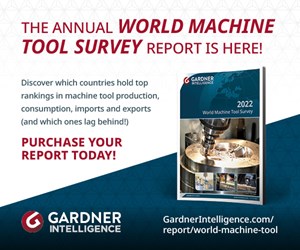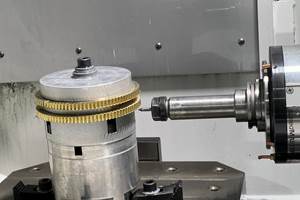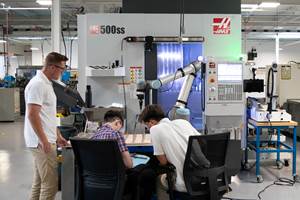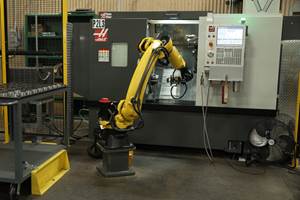5 Smart Drilling Lessons Apply Beyond the Application
A specific machine learning use case illuminates general principles for applying artificial intelligence at any CNC machining business.
Share





The following paragraphs will detail how a leading aerospace manufacturer employed artificial intelligence (AI) to identify and correct for nearly $2 million in unexplained spending on new drills. However, this article was not written only for leading aerospace manufacturers, nor for those with cutting tool spending measured in the millions. Closer examination reveals potentially valuable lessons across the spectrum of CNC machining businesses, which are increasingly reliant on shop management, machine monitoring and other software that could feed (or even incorporate) an AI. Examples of these lessons include:
1. AI works at any scale. Rick Oppedisano is founder and CEO of Delta Bravo, the AI company that helped the aerospace manufacturer achieve these benefits. Based on his description, the application sounds unlike anything I’ve ever seen on a shop visit. Massive robot arms maneuver tentacle-like about equally massive aircraft components, drilling, fastening, riveting and utterly dwarfing the people at the control terminals below to create an impression “almost like Dr. Octopus from Spider-Man,” he says.
Systems like Delta Bravo’s AI-based analytics platform, which is touted for its ability to “handle the biggest, most unconventional and complex datasets” in digital replications of enterprise-wide processes, can also seem like something from a comic book. However, 20% reductions in drill-bit spending and improved capacity utilization are the kinds of benefits that show up on a balance sheet. The data that enabled these improvements — drill thrust, torque, voltage levels — might as well have been pulled from machine tool CNCs, and the project began with only five of 500-odd workstations. Futuristic automation and the user’s deep pockets aside, the problems solved by this AI (and potentially many others) are really all about how the tool meets the metal.
Those who don’t take initial steps toward networking machines could be essentially raising a white flag.
2. Money is the best motive for AI. Oppedisano insists that “you have to identify a business case” for AI to succeed. “Is it machine downtime? Scrap? What is costing money?”
In this particular case, the aerospace manufacturer had noticed a 30% increase in drill-bit spending during a time when it was making fewer aircraft. “All they see is the bill,” Oppedisano says. “They don’t know what shift, what process, what operator — all they see are the line items.”
3.AI is data-hungry. To solve such mysteries, machine learning algorithms require a dataset that is both relevant to the problem at hand and comprehensive enough for a high-quality analysis of the problem. In the case of the aerospace manufacturer, establishing a dataset meant establishing a process chain — that is, to link tool spending to specific processes within specific programs run during specific time periods using specific drills (identified by serial number). This was accomplished by correlating process data from the robot PLCs with information from enterprise resource planning (ERP) software as well as programs for the machines.
Over time, machine learning algorithms use this data to establish and detect deviations from an ideal norm. In this case, the algorithm identified a training problem: Operators tended to change drill bits too early, wasting useful tool life while simultaneously driving spending up and machine utilization down. With an understanding of what was driving the expense, the focus shifted to how the unnecessary tool changes influenced downtime. Based on the data, the system recommends specific times for drill changes that optimize the balance between maximizing use and minimizing risk to tool and part.
4. The best AI is actionable. Success in any application requires more than just the right recommendations from a machine learning engine for solving a given problem, Oppedisano says. The execution of those recommendations must also be “complementary to existing processes.” It must “realistically fit” into how people work, and it should “allow for change.”
For example, in the aerospace application, determining how much information the interface presents to justify tool-change recommendations was a matter of careful consideration. “If you give people (too many) dashboards, eyes glaze over,” he says. Additionally, unrelated alterations in drill calibration routines had led personnel to change tools on a more conservative schedule than the AI system had suggested. The system not only provided freedom to override the recommendations without consequence, but also incorporated the change it into its process model and began to account for it in future recommendations.
5. AI is leaving many manufacturers behind. Although AI can be intimidating, manufacturers today have quick, cost-effective options for the initial step of networking machines and collecting and storing data. In fact, those who don’t take these initial steps are essentially “raising a white flag,” Oppedisano says. “Your business will be less profitable, and more susceptible to competitive threats. Others will be able to do more and do better with fewer people.”
Related Content
Investing in Automation, Five-Axis to Increase Production Capacity
To meet an increase in demand, this shop invested heavily in automation solutions and five-axis machines to ramp up its production capabilities.
Read MoreFour-Axis Horizontal Machining Doubles Shop’s Productivity
Horizontal four-axis machining enabled McKenzie CNC to cut operations and cycle times for its high-mix, high-repeat work — more than doubling its throughput.
Read MoreCNC Machine Shop Honored for Automation, Machine Monitoring
From cobots to machine monitoring, this Top Shop honoree shows that machining technology is about more than the machine tool.
Read MoreWhich Approach to Automation Fits Your CNC Machine Tool?
Choosing the right automation to pair with a CNC machine tool cell means weighing various factors, as this fabrication business has learned well.
Read MoreRead Next
Shop Tour Video: You've Never Seen a Manufacturing Facility Like This
In the latest installment of our “View From My Shop” series, explore Marathon Precision’s multi-process approach to manufacturing, where blacksmiths and hand-forged dies meet state-of-the-art CNC machining. Discover how restoring classic muscle cars and building custom art projects creates a dynamic shop culture — and draws top talent to this unique and innovative metalworking facility.
Read More2025 Top Shops Benchmarking Survey Now Open Through April 30
Modern Machine Shop's Top Shops Benchmarking Survey is now open, offering metalworking and machining operations actionable feedback across several shopfloor and business metrics.
Read MoreSetting Up the Building Blocks for a Digital Factory
Woodward Inc. spent over a year developing an API to connect machines to its digital factory. Caron Engineering’s MiConnect has cut most of this process while also granting the shop greater access to machine information.
Read More






























